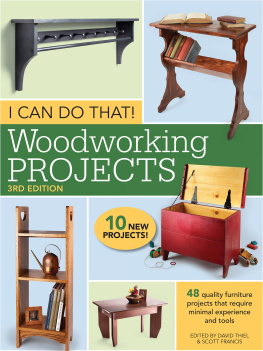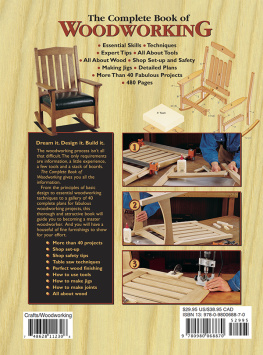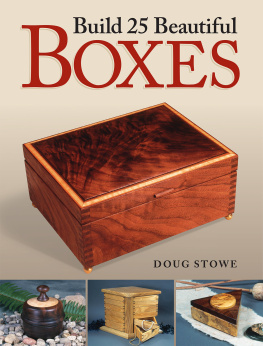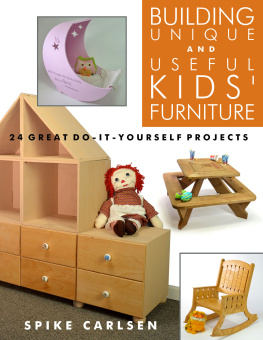
Text 2013 by Dennis Zongker
Photographs 2013 by The Taunton Press, Inc.
Illustrations 2013 by The Taunton Press, Inc.
All rights reserved.

The Taunton Press, Inc., 63 South Main Street, PO Box 5506, Newtown, CT 06470-5506
e-mail:
Editor: Joseph Truini
Copy Editor: Candace B. Levy
Indexer: Barbara Mortenson
Jacket/Cover design: Rita Sowins
Interior design: Kimberly Adis
Layout: David Giammattei
Illustrator: Christopher Mills
Photographer: Dennis Zongker
ISBN 978-1-62710-349-7
10 9 8 7 6 5 4 3 2 1
The following names/manufacturers appearing in Wooden Boxes are trademarks: Delta, DeVilbiss, Forstner , Gorilla Tape, M.L. Campbell, Magnalac, Mohawk, NOVA, Olson, Stanley Surform, Titebond, Tormek, Ultra
Working with wood is inherently dangerous. Using hand or power tools improperly or ignoring safety practices can lead to permanent injury or even death. Dont try to perform operations you learn about here (or elsewhere) unless youre certain they are safe for you. If something about an operation doesnt feel right, dont do it. Look for another way. We want you to enjoy the craft, so please keep safety foremost in your mind whenever youre in the shop.
To the loving memory of my mother, Shirley, who never had a chance to see me complete this book. No matter what I made, whether it turned out good or not so good, she would always love it just the same. I will truly miss all her encouragement, love, and support.
And also in loving memory of my sister Debbie, whose life was cut short. Thank you for always being there with a smile on your face.
ACKNOWLEDGMENTS
A LOT OF PASSION, WORK, AND DEVOTION WENT INTO COMPLETING THIS BOOK, but every moment was well worth the journey to get here. This book would not have been possible without a great deal of help from many people. Id like to express my sincere gratitude to those who have helped me along the way.
To my wife, Patti, Id like to give a special thank you for all her many hours of helping design boxes, pushing the camera shutter, and editing the chapters, but mostly for always believing in me. And thanks to her daughter, Theresa, for drawing the beautiful roses that adorn the Traditional Jewelry Box.
A very special thank you to Peter Chapman, Executive Editor at The Taunton Press, for all the hard work that went into taking my ideas, putting them together, and making this book a reality. Thanks for giving me the chance to write this book.
Thank you to Ed Pirnik, of Fine Woodworking magazine, for introducing my book idea to the book department at The Taunton Press. And thanks, too, to the designer, copyeditor, illustrator, photo editor, and layout and marketing people at The Taunton Press, each of whom played a key role in bringing the book together.
Last, but not least, thanks to Joseph Truini, my editor, for making sense out of my complex explanations and for helping a woodworker become a writer. Thank you, Joe, for all that you have taught me along the way.
And a special mention to my son, Eric: May this book take your woodworking to a new level and give you the inspiration to always strive to be your best and to never stop wanting to improve.
Contents




INTRODUCTION
BOX MAKING HAS BEEN AROUND SINCE THE time of the ancient Egyptians, and its still one of the most popular pastimes for modern-day woodworkers. Boxes can be made for all kinds of reasons: keeping playing cards, coins, and art supplies in order; protecting jewelry; storing wine; and playing music, to name but a few. They can also be made just for decoration.
Today, boxes are handcrafted by professional woodworkers and hobbyists alike. They range from simple unadorned boxes to the most elaborate designs imaginable by any craftsman. Each custom-built wooden box is unique and slightly different from any other. Box making has grown in popularity due to creativity and the joy of producing something that has never been done before.
Over the past few years I have developed a strong passion for box making, and seeing all the ways a box can be designed has opened my mind to being more creative. When designing boxes I want them to be a pleasure to look at, with carvings and colorful marquetry, but also to be pleasurable to listen to with music. My boxes often have unique features, such as segmented turnings, decorative trim, and even serpentine radius fronts that make them stand out from basic boxes.
When designing each one of the seven boxes shown in this book, I did a lot of research and used plenty of trial and error to ensure the best outcome for each one. I wanted to be able to add as many different techniques to build the readers skill from the beginning techniques to the more difficult levels of box making. Taking a mixture of the different styles can help in the design and building of a box of your own design.
This book is for all woodworkers who are looking for a new challenge. Its about teaching different woodworking techniques in joinery, different styles of cutting marquetry, perfecting radius inlays, and making your own diamond-pattern banding, to name just a few skills. Its also filled with information that will surely come in handy when working on your next box.
Ill walk you through from the simplest box to some more-complex designs. Working on each one of these boxes and coming up with new designs has been a rewarding challenge for me. Being innovative can change the basic square box into a creative design. As when learning anything new, you start simple and once you have mastered that you move on to more complex boxes with more detailed designs. Thats what I show throughout this book with each box, starting easy and working to the more difficult. The techniques youll learn can be applied to many types of projects, not just for making these unique boxes. Use them for almost any type of woodworking project.
I have thoroughly enjoyed sharing my woodworking style and techniques with others, and I hope I can help you explore new and many more possibilities. We all have to start somewhere, and with a little determination and enthusiasm, these newfound skills can open the world to creating anything your mind can imagine.

Serpentine Coin Box
I WANTED THIS BOX to be as beautiful on the inside as it is on the outside, so I combined quilted bubinga hardwood with chestnut burl veneer for a strikingly elegant look. As a complementary touch, and also to provide protection, I added solid ebony to all outside edges. The serpentine front has a convex curve in the center flanked by slightly concave ends. The box interior has three removable coin trays made from quilted bubinga, a hardwood with rich, reddish tones that will highlight your prized coin collection.
Next page














